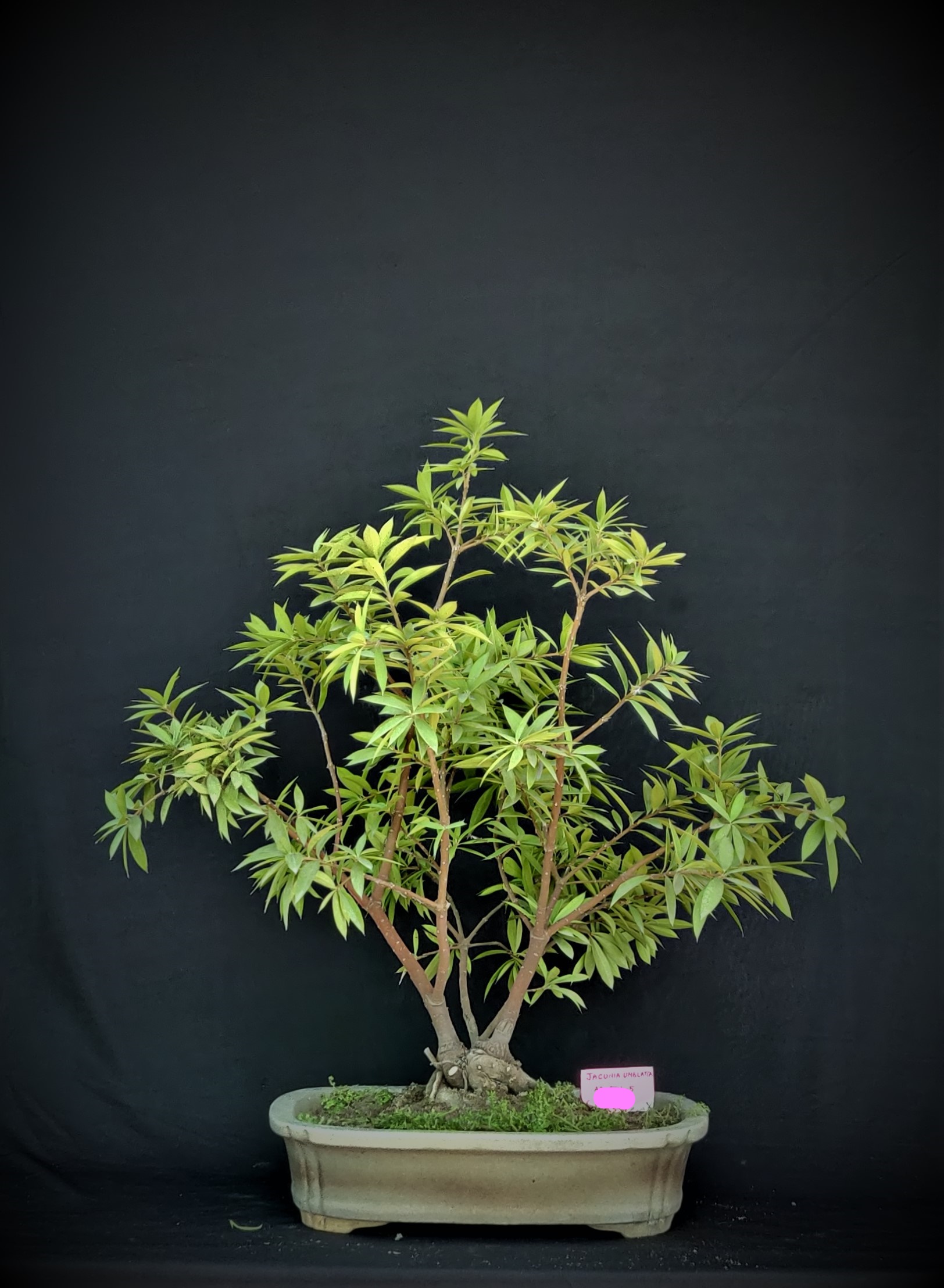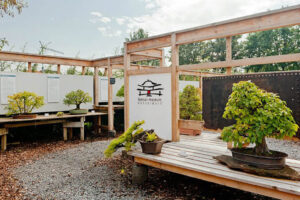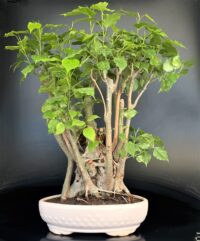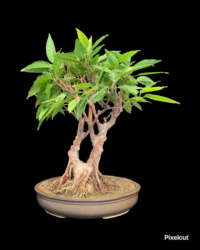Jacquinia umbellata The Amazing Bonsai
Jacquinia Umbellata Bonsai: Creating Art with Nature
Introduction
Bonsai cultivation is an art form that has captured the hearts of nature enthusiasts worldwide. Jacquinia umbellata bonsai stands out as an exquisite choice among the myriad of bonsai species. In this article, we will explore the enchanting world of Jacquinia umbellata bonsai and discover why it has become a popular choice for bonsai enthusiasts in Delhi and beyond.
What is Jacquinia umbellata bonsai?
Jacquinia, commonly known as the “Bead Tree,” is a tropical evergreen shrub native to the Caribbean. Its delicate red flowers and glossy green leaves make it an excellent candidate for bonsai cultivation. Leaves are small in size and thorny. It flowers profusely during May.
Jacquinia umbellata bonsai embodies the essence of nature captured in a miniature form. The trunk of the tree is dark brown, which looks like a mature bonsai tree. Leaves come with an arrangement of Rosette arrangement
Benefits of Jacquinia bonsai
Jacquinia bonsai offers numerous benefits beyond its aesthetic appeal. The art of tending to these bonsai trees brings a sense of tranquillity and peace to practitioners. Engaging in bonsai cultivation acts as a stress-relieving activity, allowing individuals to reconnect with nature and find solace in the intricate beauty of their creations.
History and origins
Originating from the sun-kissed islands of the Caribbean, Jacquinia bonsai carries a rich history. It has been treasured for centuries for its ornamental value and is known for its adaptability to bonsai cultivation. Through the ages, this art form has travelled across continents, captivating the imagination of bonsai enthusiasts worldwide.
Jacquinia umbellata bonsai care guide
Proper care is essential to ensure the health and vitality of your Jacquinia umbellata bonsai. Let’s delve into the key aspects of caring for these beautiful bonsai trees.
10 Expert Tips & Tricks for Gardening Bonsai
Light and temperature requirements
Jacquinia bonsai thrives in bright, indirect light. Placing your bonsai near a south-facing window or providing artificial grow lights can help maintain optimal lighting conditions. Additionally, it is crucial to protect the tree from extreme temperatures, as it prefers a mild and tropical environment.
Watering and fertilization
Proper watering and fertilization are crucial for the well-being of Jacquinia bonsai. These trees prefer consistently moist soil, but avoiding overwatering is important, as it can lead to root rot. Regularly check the moisture level of the soil and adjust your watering schedule accordingly. Fertilize the bonsai during the growing season using a balanced bonsai fertilizer to promote healthy growth.
Pruning and shaping techniques
Pruning and shaping are integral to maintaining the desired form and aesthetic appeal of your Jacquinia bonsai. Regular pruning helps stimulate new growth, maintain the bonsai’s shape, and encourage a dense canopy. Use sharp bonsai shears to carefully remove excess branches and foliage. Shaping can be achieved through wiring or clip-and-grow methods, allowing you to guide the tree’s growth and create artistic contours.
Soil and potting
Choosing the right soil and pot is vital for the health and development of your Jacquinia bonsai. A well-draining bonsai soil mixture, consisting of components such as akadama, pumice, and lava rock, provides proper aeration and moisture control. Repotting should be done every two to three years to prevent root binding and ensure the bonsai has ample space for growth.
How to make bonsai soil at home (2023)
Common pests and diseases
Like any plant, Jacquinia bonsai is susceptible to pests and diseases. Common pests include aphids, spider mites, and scale insects. Regularly inspect your bonsai and take immediate action if pests are detected. Treatments may involve using insecticidal soaps or horticultural oils. Additionally, keeping a clean and well-ventilated environment helps prevent infestations and diseases.
Jacquinia bonsai styles
Jacquinia bonsai can be shaped into various styles, each with its unique charm. Some popular styles include the formal upright, informal upright, and cascade. The formal upright style showcases a straight, upright trunk with well-arranged branches. In contrast, the informal upright style embodies a more natural, slightly slanted appearance. The cascade style mimics a tree growing on a steep slope, with the trunk cascading downward. This species can be made in various Bonsai Styles which can be seen below:
Shapes and styles of Bonsai-Simple Classification
Tips for beginners
If you’re new to Jacquinia bonsai cultivation, here are a few tips to get you started. Begin with a young and healthy tree, as it will be more adaptable to bonsai techniques. Research and understand the specific care requirements for Jacquinia bonsai. Join local bonsai communities or clubs to learn from experienced practitioners and gain valuable insights. Finally, be patient and enjoy the process of nurturing and shaping your bonsai masterpiece.
Jacquinia bonsai exhibitions

Bonsai exhibitions provide a platform for bonsai enthusiasts to showcase their artistic creations, including Jacquinia bonsai. These exhibitions celebrate the dedication and craftsmanship of bonsai artists while inspiring others to explore this captivating art form. Attending these exhibitions can be a source of inspiration and an opportunity to appreciate the beauty and diversity of bonsai trees.
Bonsai India: A Complete Guide to Buying, Growing, and Gifting Trees in India
Conclusion
Jacquinia umbellata bonsai exemplifies the artistry of nature in a miniature form. With its delicate flowers, glossy leaves, and captivating styles, it has become a cherished choice for bonsai enthusiasts in Delhi and beyond. The cultivation and care of Jacquinia umbellata bonsai offer a serene and therapeutic experience, allowing individuals to connect with nature on a profound level.
Our Motto
What you see is what you get
Delivery
Personalised delivery at door step
Mission
Creating green spaces
FAQ
Can I grow Jacquinia umbellata bonsai indoors?
Yes, Jacquinia umbellata bonsai can be grown indoors, provided it receives adequate light and proper care.
How often should I water my Jacquinia umbellata bonsai?
Watering frequency will depend on various factors such as climate, pot size, and soil composition. It is best to check the moisture level of the soil regularly and water when it starts to dry out slightly.
Can I shape my Jacquinia umbellata bonsai into unique designs?
Yes, one of the fascinating aspects of bonsai cultivation is the ability to shape and design the tree according to your artistic vision. Jacquinia umbellata bonsai can be shaped into various styles, including unique designs that showcase your creativity. With proper techniques such as wiring and pruning, you can experiment with different forms and create a truly one-of-a-kind bonsai masterpiece.
What is the best time to repot Jacquinia umbellata bonsai?
The best time to repot Jacquinia umbellata bonsai is during the early spring, just before the new growth begins. This allows the tree to recover quickly and establish itself in the new pot.
How long does it take for Jacquinia umbellata bonsai to mature?
The maturation process of Jacquinia umbellata bonsai varies depending on factors such as age, care, and environment. It typically takes several years of dedicated cultivation for a Jacquinia umbellata bonsai to develop the desired characteristics and showcase its full beauty.
Is Jacquinia umbellata bonsai suitable for beginners?
Yes, Jacquinia umbellata bonsai can be suitable for beginners, especially those who are willing to learn and invest time in understanding its specific care requirements. Starting with a young and healthy tree and seeking guidance from experienced bonsai enthusiasts can help beginners embark on their bonsai journey with confidence.
Can Jacquinia umbellata bonsai be displayed indoors?
While Jacquinia umbellata bonsai can be displayed indoors, it is important to provide it with adequate light and proper care. Placing the bonsai near a south-facing window or using artificial grow lights can help meet its light requirements.
Where can I purchase Jacquinia umbellata bonsai in Delhi?
There are various bonsai nurseries, garden centres, and online platforms where you can find Jacquinia umbellata bonsai for purchase in Delhi. It is recommended to visit reputable sources that specialize in bonsai cultivation to ensure you acquire a healthy and well-cared-for tree. Delhi Bonsai is one of the reputable online bonsai stores, committed towards providing authentic Bonsai.



